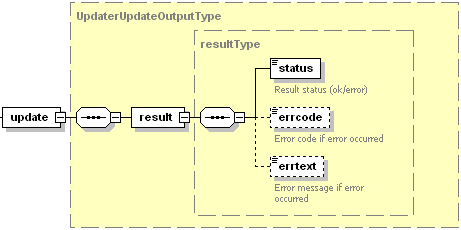Updating Plesk
The update operation is used to update your Plesk server. All components from a specified update will be affected.
Request Packet Structure
A request XML packet updating Plesk includes the update operation node:
<packet version="1.5.0.0">
<updater>
<update>
...
</update>
</updater>
</packet>
The graphical representation of the update node is as follows:

- The update-id node is required. It specifies the update ID. For info on how to retrieve the update ID, refer to the Retrieving Plesk Updates section. Data type: string.
Request sample
This request updates Plesk to 8.1.1 version.
<packet version="1.5.0.0">
<updater>
<update>
<update-id>PLESK_8_1_1</update-id>
</update>
</updater>
</packet>
Response Packet Structure
The update node of the output XML packet is presented by type UpdaterUpdateOutputType (updater.xsd) and structured as follows:

- The result node is required. It wraps the response retrieved from the server. Data type: resultType (
common.xsd). - The status node is required. It specifies the execution status of the operation. Data type: string. Allowed values: ok | error.
- The errcode node is optional. Is returns the error code if the update operation fails. Data type: integer.
- The errtext node is optional. It returns the error message if the update operation fails. Data type: string.
Samples
This request updates Plesk to 8.1.1 version.
<packet version="1.5.0.0">
<updater>
<update>
<update-id>PLESK_8_1_1</update-id>
</update>
</updater>
</packet>Response:
<packet version="1.5.0.0">
<updater>
<update>
<result>
<status>ok</status>
</result>
</update>
</updater>
</packet>
If Plesk Auto-Installer is busy, the response packet from the server will look as follows:
<packet version="1.5.0.0">
<updater>
<update>
<result>
<status>error</status>
<errcode>1035</errcode>
<errtext>Service is busy</errtext>
</result>
</update>
</updater>
</packet>